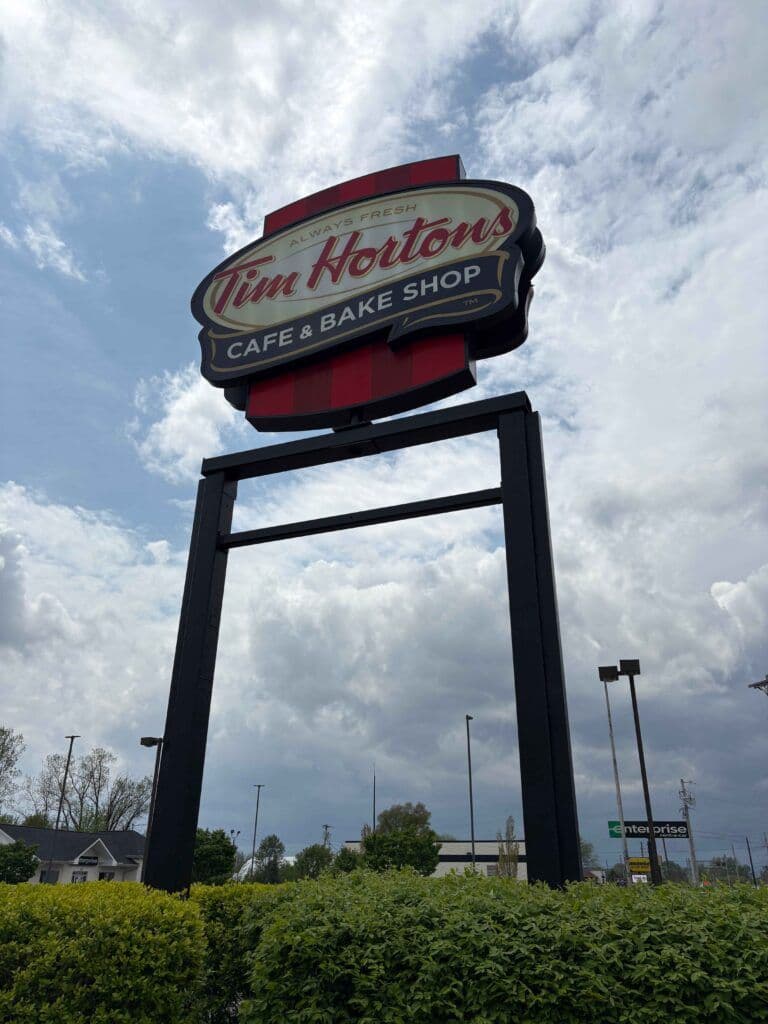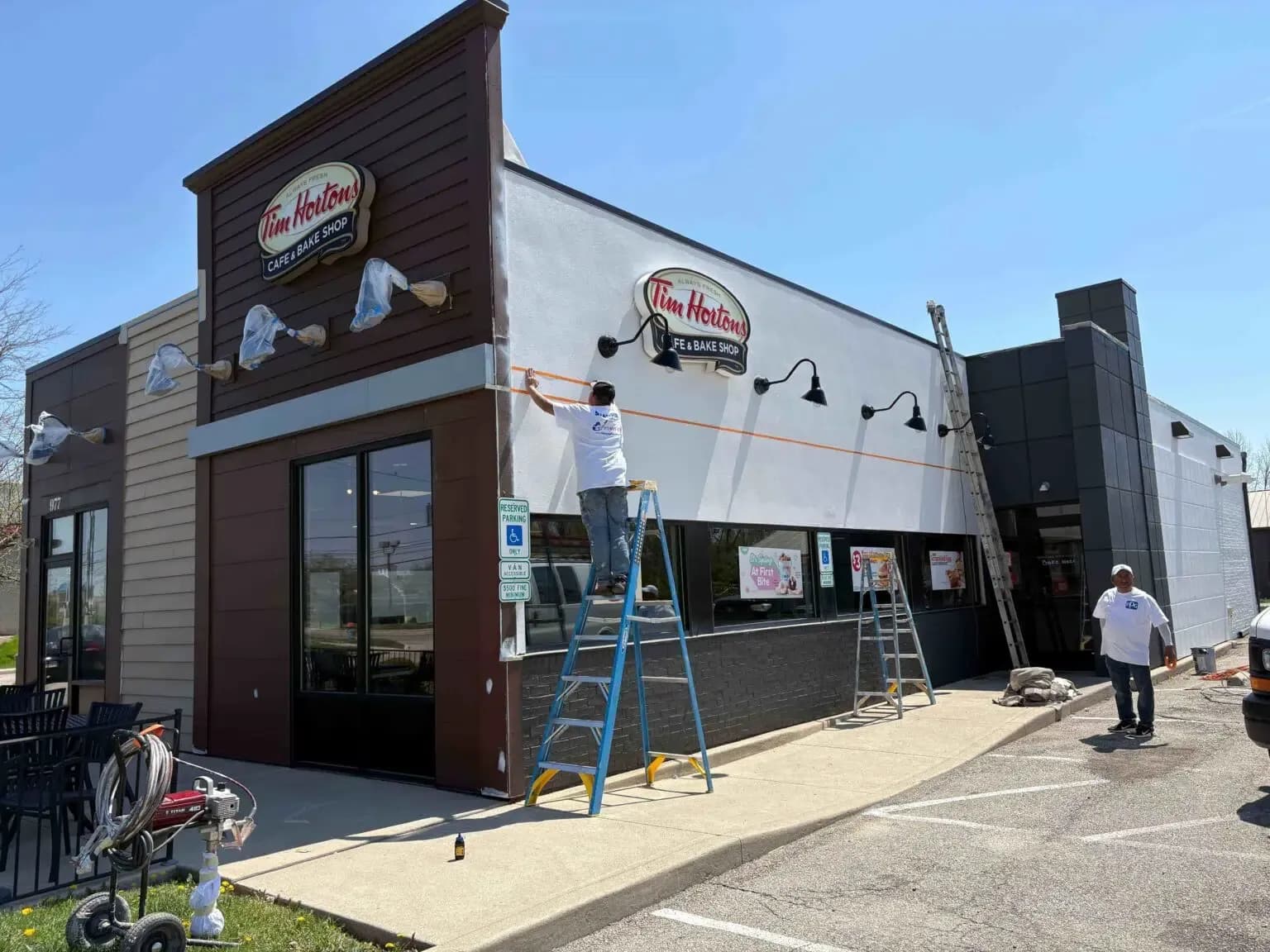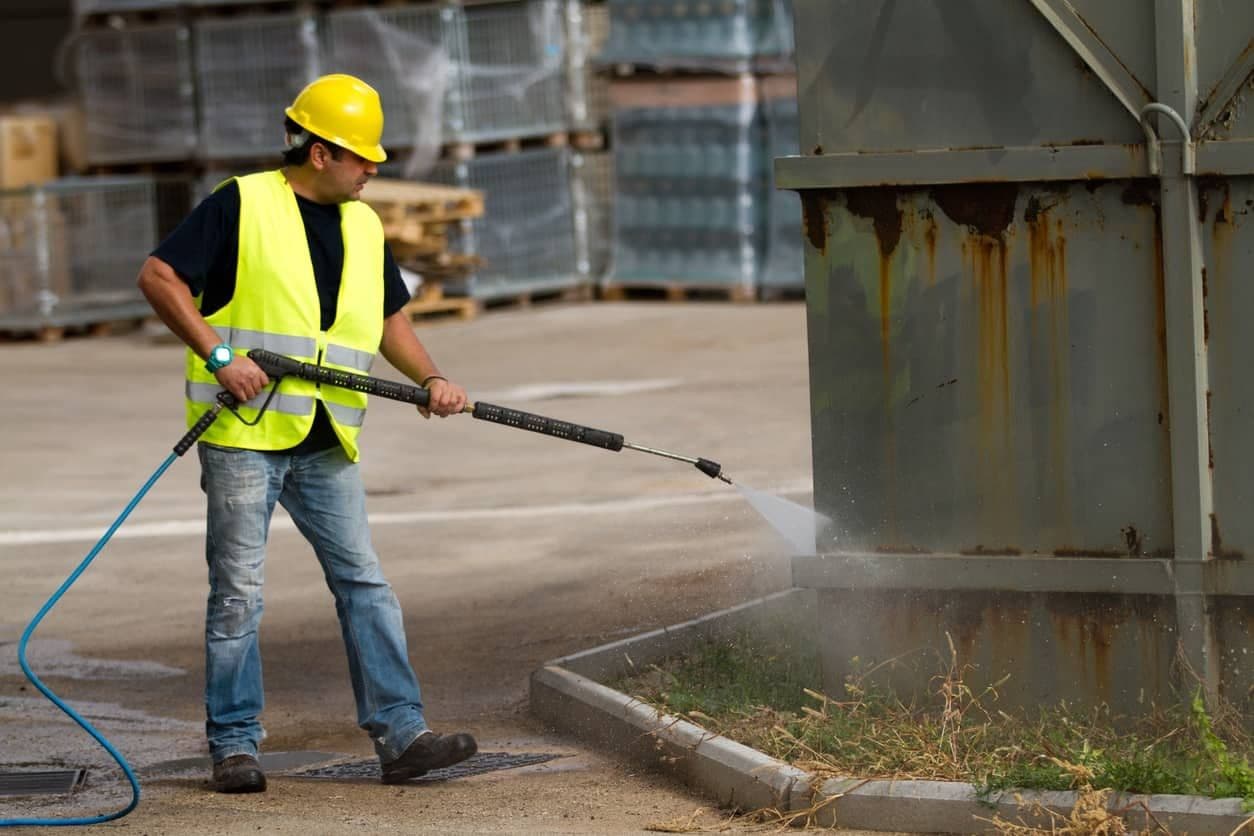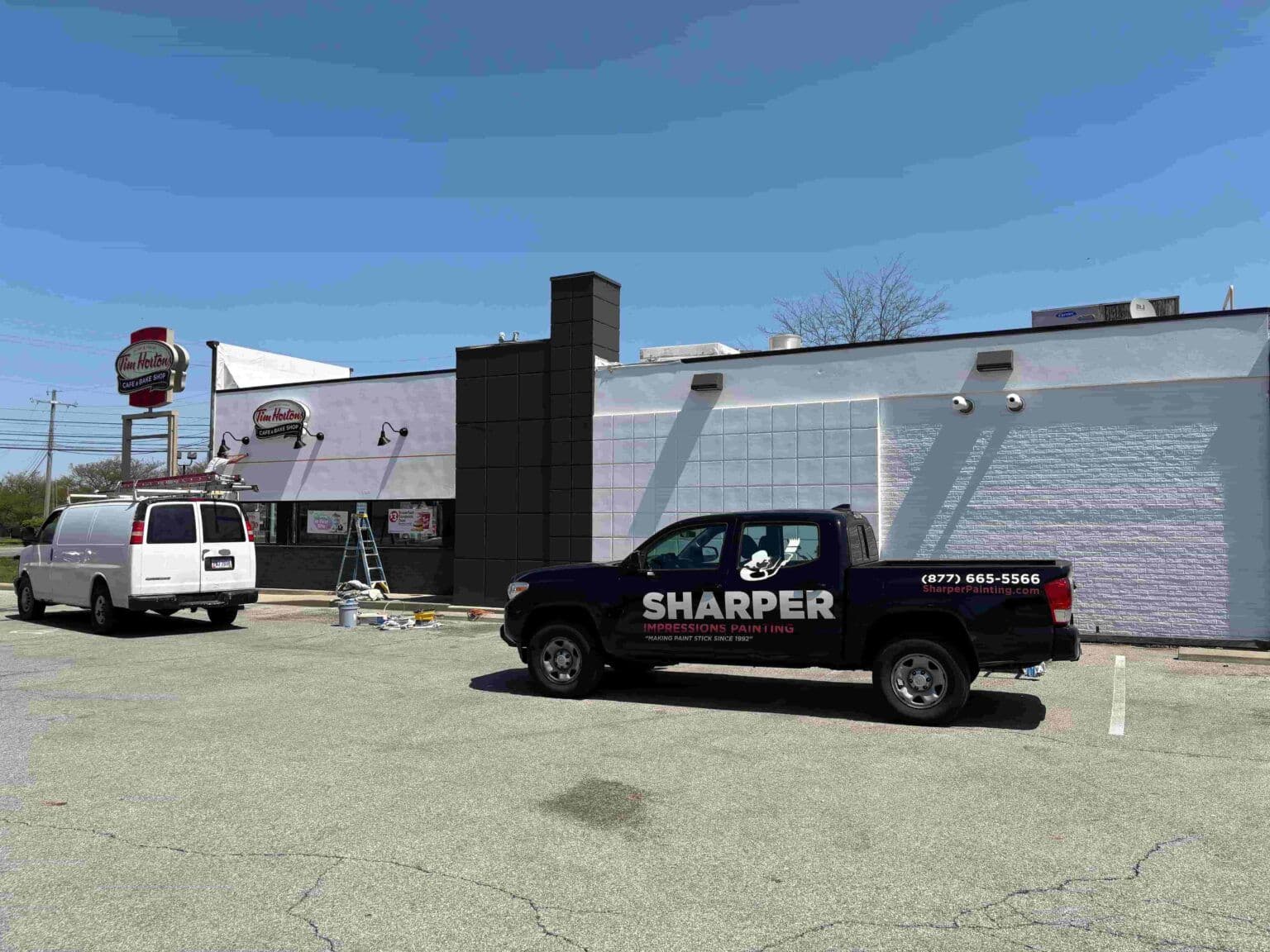Painting Resources for the Greater Columbus, OH Region
Anti-Rust Paints for Outdoor Metal Railings and Equipment

Schedule Your Quote Today!
25% Off
Ends 10/31
By submitting this form, you consent to receive SMS messages and/or emails from our company. To unsubscribe, follow the instructions provided in our communications. Msg & data rates may apply for SMS. Your information is secure and will not be sold to third parties.
Outdoor metal assets like railings, gates, loading docks, and HVAC enclosures are constantly exposed to weather, pollution, and moisture—conditions that make them highly susceptible to rust. Rust isn’t just an eyesore. It weakens structural integrity, increases liability risks, and leads to higher maintenance or replacement costs.
If you manage or own commercial properties, factories, multifamily units, or facilities with outdoor infrastructure, using the right anti-rust paint system is essential. This guide will help you choose durable, compliant coatings that extend asset life and reduce long-term costs.
Why Metal Surfaces Rust Outdoors

The Science of Corrosion
Rust is the result of a chemical reaction between iron, oxygen, and water. Steel and iron, when left unprotected, oxidize rapidly in the presence of moisture. In coastal regions, salt accelerates this process, as does industrial pollution and acid rain.
Another culprit is galvanic corrosion, which occurs when dissimilar metals—like steel touching aluminum—are exposed to an electrolyte (like rainwater), causing one metal to corrode faster.
Common Risk Zones
Outdoor structures don’t rust uniformly. Vulnerable points include:
- Weld seams and bolt connections
- Bottom railings near landscaping or sprinklers
- HVAC cages near exhaust vents
- Machinery exposed to vibration, flexing, or direct sun
These areas often trap water or absorb constant UV, speeding up surface breakdown.
The Cost of Ignoring Rust
- Safety: Rusted railings and stairs may fail under weight, leading to OSHA or ADA violations.
- Curb Appeal: Deteriorated gates or bollards make a facility look neglected.
- Budget Impact: Repainting is cheaper than replacement. Left untreated, rust eats into metal until it’s beyond repair.
Understanding Anti-Rust Paint Systems
Primer + Topcoat: A Dual-System Strategy
An effective anti-rust system includes both a rust-inhibitive primer and a durable topcoat. Skipping either step risks failure.
Types of Anti-Rust Paint Systems
Layer
Primer Bonds to bare or prepped metal and chemically inhibits corrosion.
Function
Topcoat Seals out moisture, UV, and abrasion while providing color and finish.
Types of Anti-Rust Paint Systems
- Oil-Based Enamels: Common for utility-grade use, good value, e.g., Rust-Oleum Protective Enamel.
- Acrylic DTM (Direct-to-Metal): Water-based, quick-dry, low odor, easier for occupied sites. E.g., Sherwin-Williams Pro Industrial DTM Acrylic.
- Alkyd Urethane Enamels: Higher-gloss, good abrasion resistance.
- Epoxies: Exceptional moisture resistance, high film build. Require UV-stable topcoat.
- Polyurethanes: UV-resistant, used over epoxy primers. Popular in marine or industrial environments.
- Zinc-Rich Primers: Sacrificial coatings that “corrode first,” protecting the steel underneath. E.g., ZRC Cold Galvanizing Compound.
Performance Metrics to Evaluate
- Salt Spray Resistance (ASTM B117): Measures hours of exposure before failure.
- Adhesion (ASTM D3359): Ensures coating stays bonded during expansion/contraction.
- Scrub and Impact Resistance (ASTM D2486, D2794): Key in high-touch areas.
- VOC Levels: Ensure compliance with EPA and local air quality boards.
Best Anti-Rust Paint Products for Outdoor Metals
Recommended Primers
Product
Rust-Oleum Rusty Metal Primer
Sherwin-Williams Pro-Cryl® Universal Primer
PPG Amerlock® 2
ZRC Cold Galvanizing Compound
Key Features
Oil-based, ideal for surface rust
Acrylic, fast dry, DTM
High-build epoxy, heavy-duty
95% zinc-rich, cathodic protection
Best For
Repainting old gates, railings
Occupied or public areas
Industrial equipment, steel supports
Utilities, loading docks, tanks
Recommended Topcoats
Product
Sherwin-Williams Industrial Enamel Alkyd
Benjamin Moore Super Spec HP® DTM Acrylic
PPG Break-Through!®
Rust-Oleum 9400 System
Tnemec Series 115 Uni-Bond DF
Type
Glossy, solvent-based
Satin/gloss, water-based
Acrylic-urethane hybrid
Aliphatic urethane
Industrial-grade DTM
Application
Gates, stairs, bollards
Railings near entrances
Utility boxes, aluminum surfaces
Docks, fences, walkways
Tanks, heavy-use metal structures
Surface Prep—Why It Makes or Breaks the System

Cleaning and Rust Removal
Anti-rust coatings only work when applied over clean, stable surfaces. Commercial painting contractors typically follow SSPC standards:
- SSPC-SP2 or SP3: Hand and power tool cleaning for light-to-moderate rust
- SSPC-SP6 or SP10: Commercial and near-white blast cleaning for heavy corrosion
Tools include:
- Wire brushes
- Sanders or grinders
- Abrasive blasting
- Dry ice or soda blasting for sensitive sites
Degreasing
Metal surfaces often collect oil, sap, or grease—especially near HVAC or kitchens. Degreasing with products like Krud Kutter® Pro or Simple Green Pro HD ensures proper bonding of primers.
Surface Testing
For anti-rust painting, professional painters check:
- Moisture content
- Adhesion of existing coating
- Presence of lead (for buildings pre-1978)
Why It Pays to Hire a Pro
Commercial painters assess environment, substrate, and use-case to select the right prep method. They also avoid shortcuts like painting over flaky rust, which voids most warranties.
Application Tips and Service Considerations
Environmental Conditions
Coatings must be applied in suitable conditions:
- Temperature: Typically 50–90°F
- Humidity: Low humidity prevents blushing and poor curing
- Surface dry: No morning dew or rain within curing window
Wind shielding or tents may be needed for spray applications near public spaces or sensitive vegetation.
Application Methods
- Brush/Roller: Used for touch-up or small railings.
- Airless Spray: Faster, more even coverage on fences, enclosures, and gates.
Some epoxies require mixing and induction time. Others need a UV-resistant topcoat for full durability.
Maintenance Planning
- Expected Life: 5–10 years depending on environment
- Problem Signs: Blistering, flaking, bubbling, or rust bleed-through
- Inspection Cycle: Annual check-up is a smart investment
Example: In coastal zones, a galvanized railing might need recoating every 3–5 years due to salt exposure, while inland railings may last 7–10 years.
Vetting Your Contractor
Look for:
- Written scope including surface prep method
- Product data sheets and VOC compliance
- Insurance and EPA-compliant disposal practices
- Experience with metal, marine, or industrial coatings
System Comparison by Environment
Environment
Urban Property
Coastal Site
High-Traffic Retail
Industrial Plant
Primer + Topcoat System
Pro-Cryl® + Industrial Enamel
ZRC + Rust-Oleum 9400 Urethane
Amerlock 2 + Break-Through!®
Epoxy primer + Tnemec 115
Expected Lifespan
6–8 years
3–5 years
5–7 years
8–10 years
ROI, Compliance, and Aesthetic Benefits

Cost Control Over Time
High-performance coatings reduce the need for:
- Emergency rust repair
- Full equipment replacement
- Liability claims due to failure or accidents
Safety & Legal Compliance
- OSHA: Requires safe stairs and rails in workplaces
- ADA: Enforced standards for public access areas
- Property Inspections: Insurance underwriters check corrosion control in facility assessments
Environmental and Regulatory
- VOC restrictions vary by region (e.g., California’s SCAQMD)
- Public buildings must often document coating selection for maintenance audits
- Zinc-rich or LEED-compliant coatings may qualify for tax or insurance benefits
Appearance and Brand Perception
Anti-rust paint isn’t just protection—it’s presentation.
Fresh finishes:
- Improve tenant or visitor impressions
- Reflect proactive maintenance culture
- Can be matched to your brand palette for bollards, gates, utility zones
Protect What You Own
Rust is inevitable—but it’s also preventable. By using professional-grade anti-rust paint systems tailored to the environment and metal type, you’re not just avoiding ugly stains—you’re protecting lives, lowering costs, and enhancing property value.
Whether you’re maintaining apartment stairwells, factory railings, or restaurant utility enclosures, the right coating system is a smart investment.
Request a professional coating inspection of your outdoor metal assets. Ask for a system recommendation tailored to your environment—with product specs and warranties included. And if you’re hiring a contractor, confirm they follow SSPC surface prep standards and use only trusted brands designed for long-term exposure.
June 15, 2025
About the Author: Joseph Steele
Hi, I’m Joseph Steele, with Sharper Impressions Painting. We proudly offer high-quality interior and exterior painting services for homes and businesses in Atlanta, Columbus, Orlando, Indianapolis, Kansas City, and Nashville. From cabinet painting to deck and fence staining, we’re here to enhance your space. Learn more about us here.
See what others have to say
Above All, Our Customers Come First…
Sharper Impressions Painting is a painting contractor with over 32 years of residential painting experience along with an impressive reference list from satisfied customers. Your home is your most valuable asset and our respectful painting team will make it look great and keep it protected for a long time.
Our Locations

